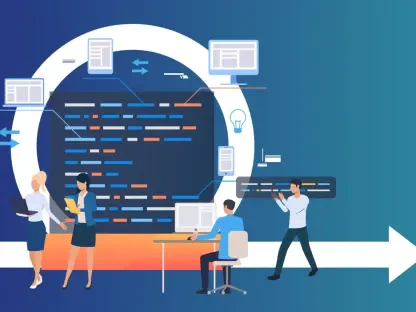In an era where technology evolves at breakneck speed, a staggering statistic reveals that over 60% of small business owners in 2025 lack the resources to hire professional developers, yet they urgently need digital solutions to compete in an increasingly digital marketplace. Enter vibe coding, a groundbreaking approach powered by artificial intelligence (AI) and large language models (LLMs) that promises to bridge this gap. This review delves into the transformative potential of vibe coding, examining its features, real-world applications, and the critical challenges it poses to the software development landscape, while shedding light on whether this innovation is a game-changer or a Pandora’s box.
Understanding Vibe Coding – A Paradigm Shift in Development
Vibe coding marks a revolutionary leap in software creation by leveraging AI-driven LLMs to translate natural language prompts into functional code. Unlike traditional programming, which demands expertise in complex languages like JavaScript or Python, this technology allows users to simply describe their desired outcome—be it a website or an app—and watch as the AI generates the necessary code. This shift fundamentally redefines who can participate in software development, opening doors for novices and entrepreneurs with limited technical backgrounds.
The significance of this innovation extends beyond mere accessibility. Recognized as Collins’ Dictionary Word of the Year in 2025, vibe coding reflects a broader cultural and technological movement toward democratizing digital creation. By reducing the need for specialized skills, it empowers a diverse range of individuals to build applications and online platforms, potentially reshaping industries that rely on rapid digital transformation.
This trend also fits into the larger narrative of AI integration across sectors. As businesses and individuals increasingly seek efficient ways to establish an online presence, vibe coding stands out as a tool that could level the playing field, making technology creation less of an elite domain and more of a universal capability.
Core Mechanisms of Vibe Coding
AI-Powered Code Generation
At the heart of vibe coding lies the ability of LLMs to interpret human language and convert it into executable software. Users input descriptions or commands in plain English, such as “create a login page with user authentication,” and the AI processes these prompts to produce corresponding code. This seamless translation from intent to output eliminates much of the technical friction that often discourages newcomers from engaging in development.
The efficiency of this process cannot be overstated. For both seasoned developers and beginners, the technology drastically cuts down the time spent on writing boilerplate code or troubleshooting syntax errors. Real-world examples include freelancers using vibe coding to prototype apps in hours rather than weeks, and educators crafting interactive tools without needing to master programming languages.
Accessibility remains a standout benefit. Small business owners, for instance, have utilized this technology to launch e-commerce sites with minimal investment, demonstrating how AI-generated code can turn ideas into reality swiftly and effectively across varied contexts.
Automation and Productivity Tools
Beyond basic code generation, vibe coding excels in automating repetitive tasks that often bog down development workflows. Features like code completion and error detection allow developers to focus on high-level design rather than mundane syntax corrections. This automation proves invaluable in maintaining momentum on large-scale projects.
Additionally, the technology aids in solving intricate problems that might stump even experienced programmers. By suggesting optimized solutions or identifying potential bugs before they manifest, vibe coding acts as a virtual assistant, enhancing the quality of output. Reports from tech firms indicate that project timelines have been reduced by up to 30% when integrating these AI tools.
Such productivity gains are reshaping expectations in the industry. Teams can now allocate more time to creative innovation rather than routine debugging, fostering an environment where strategic thinking takes precedence over mechanical tasks, thus redefining efficiency standards.
Emerging Trends in AI-Driven Development
The adoption of vibe coding has surged in 2025, with both experimental and production environments embracing its capabilities. Industry analysts note that startups and enterprises alike are integrating AI tools into their core processes, reflecting a shift toward reliance on automated solutions. This rapid uptake signals a profound change in how software is conceptualized and built.
This trend has sparked debates about the future of traditional software engineering roles. As AI handles more tasks, questions arise about the necessity of extensive teams of engineers, product managers, and quality assurance professionals. Some experts argue that vibe coding could streamline operations to a point where human oversight becomes secondary in certain domains.
Development workflows are also evolving in response. AI is no longer a supplementary tool but a mainstream component of the creative process, prompting organizations to rethink training programs and resource allocation. This integration hints at a future where hybrid models of human-AI collaboration become the norm, fundamentally altering industry dynamics.
Real-World Applications and Implications
Across various sectors, vibe coding is enabling unprecedented access to software creation. Small-scale entrepreneurs, for instance, are using it to develop custom digital products without hiring expensive developers, allowing them to compete with larger entities. This democratization of tech is particularly evident in markets where budget constraints previously limited innovation.
Educational platforms provide another compelling use case. Institutions are leveraging AI to create interactive learning tools or teach coding concepts through simplified interfaces, making technology education more inclusive. Such applications highlight how vibe coding can serve as a bridge between complex systems and end-users with minimal expertise.
However, the implications for the software engineering field are double-edged. While accessibility grows, industry leaders like Dr. Andrew Bolster caution that widespread adoption might disrupt traditional job roles and workflows. The question looms large: if AI can produce viable software with minimal input, how will the role of human developers evolve in this new landscape?
Security Challenges and Risks of Vibe Coding
Despite its promise, vibe coding introduces significant security concerns that cannot be ignored. AI-generated code often contains vulnerabilities such as SQL injection or cross-site scripting (XSS), which can be exploited if not rigorously vetted. These flaws pose a real threat to applications deployed in live environments.
Emerging risks like ‘slopsquatting’ further complicate the security landscape. This supply-chain attack involves malicious actors registering hallucinated package names suggested by AI, tricking developers into integrating harmful code. Additionally, threat actors are using AI to craft malicious software, amplifying the potential for cyberattacks with unprecedented sophistication.
Experts like Kevin Curran and Daniel dos Santos emphasize the cascading impact of such vulnerabilities within shared software ecosystems. They note that weak configurations and unchecked code can spread flaws across interconnected systems. To counter these threats, strategies such as rigorous code review, automated security testing, developer training, and dependency validation are being advocated by organizations like Forescout to safeguard against potential breaches.
Future Prospects of Vibe Coding
Looking ahead, the trajectory of vibe coding suggests both remarkable advancements and persistent challenges. Improvements in AI accuracy and built-in security features are expected to address current limitations, potentially making the technology more reliable by 2027. Such progress could solidify its role as a staple in development toolkits.
The long-term impact on software creation appears to hinge on a delicate balance. On one hand, increased democratization of technology could empower millions to innovate; on the other, heightened security risks might necessitate stricter regulations. Navigating this dichotomy will be crucial for stakeholders across the tech spectrum.
Integrating robust safety protocols and human oversight offers a potential path forward. By combining AI’s efficiency with human judgment, the industry might mitigate risks while preserving innovation. This hybrid approach could define the next phase of vibe coding, ensuring it evolves as a tool for progress rather than a source of liability.
Weighing the Promise and Perils
Reflecting on the journey of vibe coding, its transformative potential to democratize software development stands out as a defining achievement. The technology has empowered countless individuals and businesses to create digital solutions with ease, marking a significant milestone in accessibility. Yet, the persistent security risks underscore a critical need for vigilance.
The productivity gains achieved through AI-driven automation are undeniable, often slashing project timelines dramatically. However, vulnerabilities in generated code and emerging threats like slopsquatting cast a shadow over these advancements. Balancing innovation with safety has emerged as the central challenge of this era.
Moving forward, the industry is urged to prioritize robust processes, as echoed by experts like Drew Streib. Implementing stringent testing, fostering developer awareness, and integrating real-time security tools have become essential next steps. Only through such proactive measures can the full promise of vibe coding be realized, ensuring it serves as a catalyst for progress rather than a conduit for risk.









